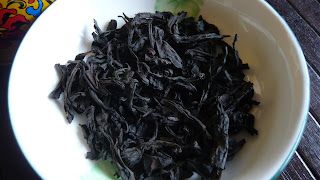 I have been interested in the "Sea Dyke Phenomenon" for a while, and have written about two Sea Dyke oolongs here and here. The interest is partially from the good deals that I've got from Sea Dyke, and partially from conversations with older tea drinkers. Many of these older people are not as much of expensive tea drinkers as me, although I'm not the typical expensive tea drinker compared with many other tea drinkers I know.
I have been interested in the "Sea Dyke Phenomenon" for a while, and have written about two Sea Dyke oolongs here and here. The interest is partially from the good deals that I've got from Sea Dyke, and partially from conversations with older tea drinkers. Many of these older people are not as much of expensive tea drinkers as me, although I'm not the typical expensive tea drinker compared with many other tea drinkers I know.These older tea drinkers drank inexpensive tea throughout their lives. However, I feel their "tea life" is not shallow at all. They have their own "tea theories" and tea passions. Like what the Chinese proverb says, "...(older people) have had more salt than all the rice we've had; the bridges they've walked across sum up to many more miles than all the roads we've ever traveled; they've had more tea than all the water we've ever had..." - the last section is my addition, and the first two sections are from the original proverb :-p

These stingy older people have their own tea wisdom. After all, tea is never a single-dimensional experience. There are many tea factors to pursue, highest grade, best harvest date, highest prices... but none of them is the single most important pursuit.
Sea Dyke oolong, although very inexpensive, was once the "upscale tea" in the old days in many older tea drinkers' eyes. In today's tea market, it's not really an upscale tea, but a lot of older people are life-long fans of this tea. This brand is part of the history. Some of its products, in my eyes, are surprisingly good for their prices. In today's tea market, there are a lot of products better than Sea Dykes. But there are also a lot of people paying much higher prices for tea that's not even as good as Sea Dyke's tea - this happens a lot in China, and I guess it happens in the States and other countries as well.
Usually the "yellow can" Shui Xian all look the same. But this one produced in 2011 has an extra stamp on the box saying it's sort of "collection edition". I guess this is because Sea Dyke finally picked up with commercial promotion and realized they should make full use of their historical fame. The contents are supposed to be same between regular edition and collection edition.
The tea is a typical machine roasted tea. It's not super outstanding, but is never as weird as some light roast yan cha in the new trend of early 2000s, nor as pretentious as some other heavy roast yan cha that has nothing but fire taste. This is a mass production tea, but is mass produced by people with decades of experience, and is somewhat quality-controlled by tea drinkers of as much experience.
The spent leaves also show that this is a machine roasted tea. It's relatively high fire, even for a yan cha. And I think, that has to do with that the leave are not top grades. But that's what Sea Dyke is, mediocre but passable leaf grade, machine roast, plain price.
I think Sea Dyke products are also good for a beginner tea drinker to compare machine roast and manual roast (such as this one) without having to suffer from a poorly made machine roast.
The tea liquor doesn't feel as sticky as some top grade yan cha, but usually it has no problem giving 7 good infusions, or a little more. This tea does require at least a few months (or more) to rest and have the "fire taste" faded. Otherwise it would feel too "hot and dry" in your mouth and nose. In contrast, some of the top grade yan cha I've tried in recent years, would taste already good upon the time of being released by the producers, which can be as soon as about 3 months after roasting. These top grade teas would still improve with further resting, but since they are roasted to exactly a suitable degree, and rested by the producer throughout a right amount of time, they would be good to go by the time they are on the shelf.
Sea Dyke is a very interesting tea brand, and is probably one of the very few tea brands that are worth buying in a Chinatown grocery store (if available). There are quite a few things about Sea Dyke that I think are very interesting. And one of the most interesting is its price.
1. The price is generally low. In recent years, they've started several "fancy" lines of products. But overall the prices are low. And in southern China, many older tea drinkers trust the inexpensive "traditional product lines" more than the fancy, expensive (still cheaper than a lot of other brands) new product lines. It's not just out of habit or monetary considerations. Some people would say, the traditional product lines are the factory's major export products and their most representative products. And some people believe the older product lines result from years of experience and some new product lines were created to just follow the most recent market trend.
2. The price is lower abroad than in China, and this always amazes me. Both this tea and the other yan cha of Sea Dyke I blogged about have significantly lower price abroad than in China. The regular edition (not this "collection edition") "yellow can" Shui Xian's manufacturer's suggested retail price in China is about 100 rmb (1US$ = approx. 6.2 rmb). But if you see it in a Chinatown grocery, chances are the price would be lower than $8. The last time I checked with friends in South Eastern Asia, the price of this tea, as well as prices of other Sea Dyke teas, are even lower than prices in US! I guess the main reason is quite a few Sea Dyke teas have been export products for the past several decades, when China was desperately in need of US dollars. So after the domestic market prices of teas increased, to keep their competition edges, their prices in international market didn't increase much.
According to a friend knowing more about international trade (and this is somewhat beyond my understanding and has yet to be verified), another reason that a lot of Chinese products are cheaper in the international market is because the trade chain is stable, and the producers (especially those state-owned businesses) wouldn't have to do much more than shipping their products abroad and taking money. In contrast, there have been too many changes in Chinese market all the time in the past decades in terms of wholesalers, distributors, province rules, etc. Then it ended up costs more selling within China than out of China. This sounds a little ironic!
3. And here is an even bigger irony... around 2009, this "yellow can" caused some market hype. Suddenly, a lot of newer tea drinkers realized this tea was too good for its price. And therefore for some time, this tea was completely sold out in most places. Some dealers stocked up this tea and sold it for twice the official price in Northern Chinese cities like Beijing. This tea has 125g in a can. For 100 rmb per can, I would say, few producers can beat the price. After all, the state-owned larger factories can manage to have low operational costs that can hardly be matched by regular producers. But for 200 rmb per can, I don't think it's a good deal anymore. Yet this tea was still sold out fast at the high price. What does it mean? I guess, this tells us before "yellow can" was (re-)discovered, a lot of people in Northern China paid even higher prices for crappy yan cha.


































3 comments:
I just got a can of Shui Xian Sea Dyke off ebay for $20. I cant help but laugh everytime I say the name "Sea Dyke". ;)
the can is beautiful -- I would purchase the tea in order to collect the can.
I love a good Oolong tea, but I've never tried this one. I can't believe the price. That's amazing...I definitely need to get a can.
Post a Comment